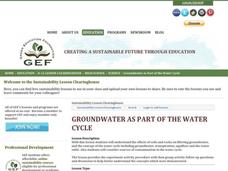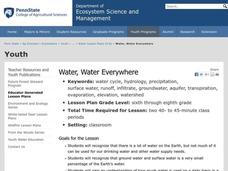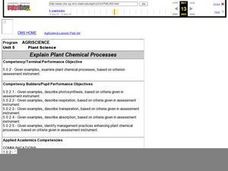Curated OER
Moisture Makers
Learners use cobalt chloride paper to find moisture in leaves. In this moisture content investigation, students compare and contrast the amount of water given off by various leaves.
Curated OER
Transport in Plants
Quite a detailed and advanced look at the transport mechanisms of a plant. The absorption and control of sugar and water concentration are explained and will help an understanding of homeostasis concepts and organ specialization.
Curated OER
Groundwater as Part of the Water Cycle
Make sure to read through the activity procedures thoroughly before teaching this lesson because the materials list is incomplete. Also, the mentioned worksheets and booklet are not available. However, there is no need to discard this...
Curated OER
Clouds: A weather Predictor
Predicting the weather can be as easy as understanding cloud formations. This presentation elucidates to the reasons clouds exist and how they are classified into four different types, cumulus, stratus, vertical, and cirrus. Tip: Take...
Curated OER
The Water Cycle - Main Components
Present the water cycle to your middle schoolers with this instructional activity. After an anticipatory set, they participate in a Q & A session about the terms associated with the water cycle: evaporation, transpiration,...
Curated OER
Photosynthesis
High schoolers conduct a variety of experiments on photosynthesis. In this biology lesson plan, students identify the factors required for the process to occur. They perform computerized experiments to test the amount of oxygen produced...
Curated OER
Water Cycle
Second graders investigate the water cycle. In this water cycle instructional activity, 2nd graders discover how the water cycle effects erosion and weathering. Students create their own terrariums to view the water cycle. Students...
Curated OER
How Trees Contribute to the Water Cycle
For this water cycle instructional activity, 3rd graders conduct an experiment where they observe and calculate how water transpires in different types of trees. Students engage in a class discussion and use Venn Diagrams to...
Curated OER
Amazing Transpiration
Learners observe a leaf and discuss the way that water is released from a leaf through its stomata. For this water cycle lesson, students calculate how much water leaves produce from a whole tree.
Curated OER
Transportation in Plants
Students investigate how plants transport water and nutrients through the plant. In this transportation in plants lesson plan, students use glass tubing, celery stalks, food coloring and leaves from plants to observe adhesion and...
Curated OER
Planting
Fifth graders study the parts of a plant and how they live and grow. In this plant growth lesson plan, 5th graders investigate the processes that plants go through to produce oxygen and release moisture. Diagrams, images, and background...
Curated OER
Plants and the Water Cycle
Students study the role of plants in recycling water by collecting water vapor that is emitted, or transpired, by green plant leaves. They collect and measure the water that transpires through the tiny pores of plant leaves. Afterwards,...
Curated OER
Landscaping and Urban Forestry - Lesson 4 (Grades 5-6)
Students discuss reasons to plant trees and the best locations for cooling. They analyze two homes identifying types and locations of trees, and location of the central air conditioners. The benefits of shade, the process of...
Curated OER
Plant Life Cycles - Chapter #2
Call this just a template for a presentation on plant life, not life cycles as the title implies. Content does compare the lengths of different life cycles and describes required conditions for germination, but it also explores cellular...
Curated OER
AP Biology Lab Review
A seventy-two slide PowerPoint that reviews several lab explorations done in an AP Biology course. For each lab there is a description, concepts, and conclusions. Many pictures and graphics make this visually appealing, but it would not...
Curated OER
Academic Raceway 500: Weather
This weather PowerPoint features a game in which students advance to the finish line with a race car as they answer questions related to weather. Topics include types of clouds, weather instruments, the water cycle, and various weather...
Curated OER
Stomata
Students explore what the stoma does for a plant. In this botany lesson students complete a stomatal peel experiment and measure its densities.
Curated OER
Transpiration
Students interactively explore the term transpiration. In this science/ecology lesson, students discuss what they would do if they were thirsty while conducting research in Brazil. Additionally, students write descriptive words to...
Curated OER
Water, Water Everywhere
Students recognize that all of the water on earth cannot be used for drinking and that the percentage of ground and surface water is a small percentage. In this water lesson students identify ways to conserve water.
Curated OER
Water Cycle
Students observe an example of evaporation and study the water cycle. In this research lesson students simulate a cloud formation and create a model of the water cycle.
Curated OER
Plant Life
In this plant worksheet, high schoolers will review plant classification by comparing plant characteristics. Students will determine what is needed for photosynthesis to occur. High schoolers will also explore plant transpiration and the...
Curated OER
Air and Water in the Environment
Second graders participate in a three part activity in which they identify and describe forms of moisture in the environment. Part one of the activity involves the three stages of the water cycle, part two focuses on creating humidity...
Curated OER
Capillary Action And Transpiration
Young scholars engage in a study of the concepts of biology with plants known as capillary action and transpiration. They conduct a simple experiment to demonstrate the concept. The lesson plan includes a background discussion led by the...
Curated OER
Explain Plant Chemical Processes
Students discover plant chemical processes through three lab activities. Overheads, data sheets, and teaching procedures provided for the unit covering photosynthesis, respiration, and transpiration.

























